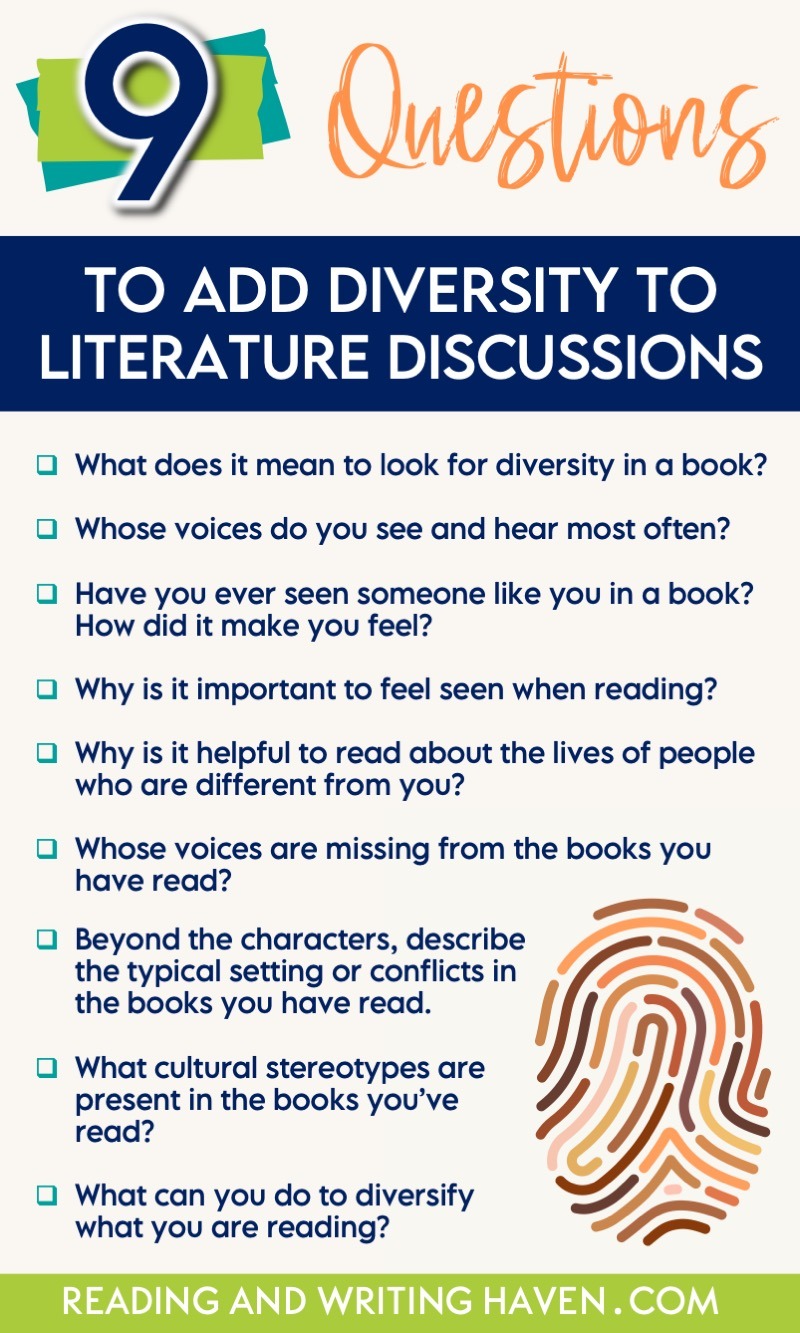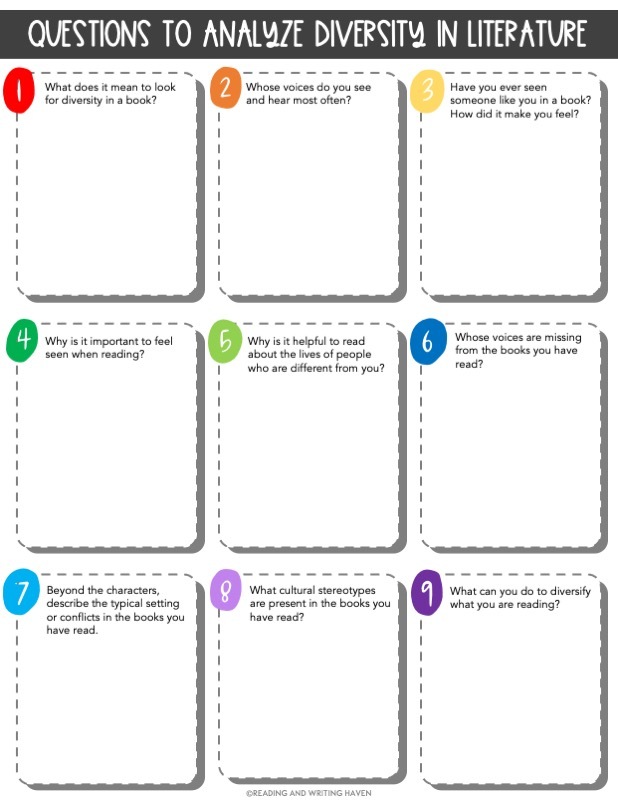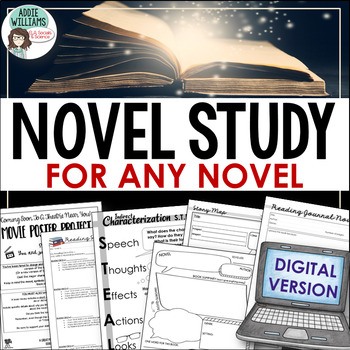9 Questions that Help Students Analyze Diversity in Literature
Inside: Wondering how to help students analyze diversity in literature? This post includes nine reflective questions to help guide conversations.
It felt gigantic. The more she thought about it, Hailey couldn’t escape the weight of all of the books she needed to add to her library…the conversations she needed to have…the learning she needed to do.
Anytime we are faced with a big goal, especially one that will propel us forward in our teaching careers, it’s typical to feel overwhelmed. Recently, there has been an increase in conversations around diversifying classroom libraries and literature lessons.
Doing so can feel nebulous and daunting to anyone who is in the initial stages. The details of what, why, and how nip at our heels.
Finding a starting point…
I try to connect with as many educators as I can both online and in person, and as I was thinking about starting points that would help those who are working through this process, it didn’t take me long to think of my friend, Addie Williams.
Addie has been a secondary English teacher and school librarian for over twenty years. She’s spent much of her time trying to add a wide range of voices to her school library to ensure that all students are included and feel seen.
I asked her to sit down and chat…to share her learning. Luckily for us, she is always ready for a healthy conversation. As we talked, the topic grew bigger…and bigger…and we both finally agreed we needed to narrow it down, or we’d end up with a book!
Eventually, one of Addie’s insights helped to ground this post in a more specific focus.
When it comes to diversifying lessons and literature, teachers often feel they need to reinvent the wheel. It’s not necessary! Do the same thing you would do with the classic book, but pair classics with contemporary pieces or use questions that allow for perspective taking and empathy. You don’t have to completely change how you teach ELA or novels when thinking about diversity.
So that’s what we are looking at here. Addie and I crafted 9 example questions you can use with students to spark conversations about diversity and literature. As you read through these examples, reflect on 10 books you’ve read over the last 10 years (even childhood books!). Using that list, how would you answer these questions?
9 WAYS TO ANALYZE DIVERSITY IN LITERATURE
Question #1
What does it mean to look for diversity in a book”?
For this question, students may point out we are looking for literature that features a voice that is different from our own. These voices could include a different ethnicity, culture, gender, country, religion, orientation, ability…and so on.
Appreciating diversity means we value what makes us similar to and different from those around us. It may be helpful to ask students to talk about unique traits of characters in their books. How do those characteristics present challenges for the character? But how are they also traits to be embraced and celebrated?
Question #2
Whose voices do you see and hear most often?
Students can talk about specific voices in as they analyze diversity in the literature they read. Encourage them to expand their thinking to include disabilities, learning styles, communities, socioeconomic factors, religion, morals, values, traditions, race, ethnicity, and gender, among many other considerations.
What would life be like if every tree were the same height, shape, and color? If every town were a clone of the others? Connect those visuals to what the world would be without diversity. What kinds of traditions and holidays would exist? What would we gain, and what would we lose? Finally, students can connect that line of thinking back to the original question about the voices they see and hear most often in their books.
Question #3
Have you ever seen someone like you in a book? How did it make you feel?
Students may respond that they have seen many people like them in a book, and perhaps that’s why they were pulled into the story. They could relate to the culture, lifestyle, friendships, and challenges. Perhaps they felt validated, seen, or included.
Conversely, students may say they have not read many books with characters like them. In this case, students may find learning about other cultures interesting, or they may feel left out or unable to identify with the characters, setting, or storyline.
Question #4
Why is it important to feel seen when reading?
Students who are not used to feeling represented in literature are often excited to see themselves reflected in what they are reading. In general, it makes people happy to be seen, heard, and appreciated.
If students are constantly reading books they are not represented in, they can begin to question their presence in the world. When students see themselves in literature, it validates who they are…affirms their identity. Students see their lives reflected in the larger body of human existence.
Question #5
Why is it helpful to read about the lives of people who are different from you?
Learning about others can give us a better understanding of cultures, religions, ethnicities, and the lived experiences of people we might not get to know or understand otherwise. When people gain an understanding and see that, despite differences, we all have commonalities, we are less judgmental and more open-minded. Reading about others builds empathy and hopefully a respect for differences and the importance of equity.
By reading different voices and perspectives, we can gain insights about the world. Beyond the walls of our homes, neighborhoods, schools, and communities, there are many people who live differently than we do.
Reading some of these voices and perspectives educates us, expands thinking, and helps us to ground our understanding of the world. Depending on the student they may have very little experience reading about themselves and have only ever read books from different voices.
Question #6
Whose voices are missing from the books you have read?
People tend to gravitate toward a specific style of book. We fall into authors, genres, and series we love. And, that’s great! But, it can be helpful to reflect on what voices we are hearing as well as what voices may be missing from our reading list. Historically, we have overall been missing the voices of many groups of people.
How many books have students read by someone who is Black, Indigenous, LatinX, or Asian? What about voices of people with visible or invisible disabilities? Students will come up with many other examples to consider.
Question #7
Beyond the characters, describe the typical setting or conflicts in the books you have read.
As students analyze diversity in literature, it may help them to think about the setting in many of the books they have read. Are the books set at a college prep high school or in an affluent neighborhood? Do the books take place in an urban or rural setting? What groups of people live in these communities? Setting can help students realize, from a different angle, how the books they are reading are mirroring their reality or providing a window into a different “world.”
Conflicts – both internal and external – can help students to connect with characters who are similar to and different from them. No matter where we live, or what color our skin is, decisions can be difficult, life can be stressful, and relationships can be challenging.
Question #8
What cultural stereotypes are present in the books you’ve read?
Stereotypes can be difficult to discuss for many reasons. When giving students examples, it helps to stick to animals or “funny” angles. For instance, All police officers like donuts, or (in movies) hyenas are cowards.
While reflecting on books they’ve read, students may choose to write about stereotypes that relate to how our world often views girls versus boys. In literature, do girls often have boundaries with extracurriculars, jobs, or chores? Another example might be race related. Is the gangster Black? The mathlete Asian?
When discussing stereotypes, it’s important to help students realize that they exist, but that it’s important to see past them – both in real life and in literature. People form stereotypes based on inferences about a group’s social roles. Usually, these inferences are made from an outsider’s limited perspective. Having a desire to learn more about people’s differences is important to avoid perpetuating stereotypes.
Question #9
What can you do to diversify what you are reading?
We can encourage students to set reading goals for books. What voices are they used to hearing? Whose voices would they like to learn more about?
It’s helpful to model for students how we personally add YA books to our “to read” stack and intentionally prioritize a wide range of voices. If you’d like inspiration, you could follow hashtags like #weneeddiversebooks or #ProjectLitComm to find new books.
. . . . . . . . . . . . . . . . . . . . . . . . . . . . . . . . . . .
Learning to talk about diversity in the classroom can be uncomfortable, but it helps to build inclusive learning spaces. Talking about diversity shouldn’t be political or religious. Diversity conversations just mean we are making space for learning about those who are different from us…as well as appreciating connections we have with those who feel distant.
When prompting students to analyze diversity in literature, remember! It doesn’t need to feel like a gigantic shadow is looming overhead. You don’t have to reinvent the wheel. Open up conversations about perspectives, and let students share their voices.
We never know what’s going to be a break-through book for a student. We owe it to kids to give them the chance to see themselves in a book, which might just turn them into a reader!
Addie and I hope this post has provided some simple questions for helping students reflect on their reading and analyze diversity in literature. If you’d like to use these questions in the classroom, you can grab a copy here.
About Addie
Addie Williams has been a middle and high school English teacher and school librarian for 20+ years. She has spent much of her time over the last few years trying to add a wide range of voices in her school library to ensure that all students feel included and seen. Addie works to amplify the voices of people who historically have not been included in classroom readings, curriculums, and on the books found on the library shelves. You can connect with Addie on Instagram or on her blog.
Addie’s novel study resource (pictured below) can be used with any book – whether it’s a brand new YA book or a long-time classic. We can engage students in analyzing story elements while digging into diversity discussions with ANY novel.



